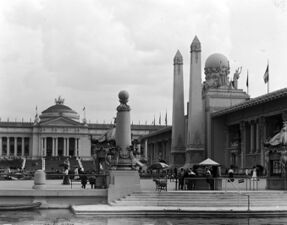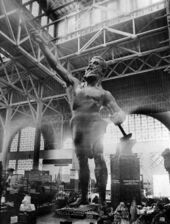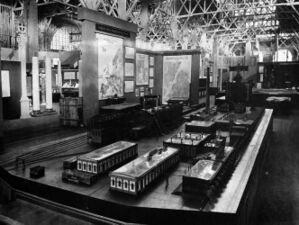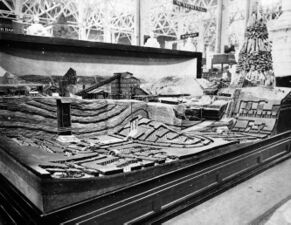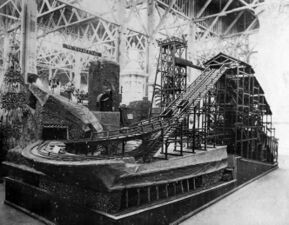Palace of Mines & Metallurgy: Difference between revisions
No edit summary |
No edit summary |
||
| (5 intermediate revisions by the same user not shown) | |||
| Line 24: | Line 24: | ||
| ticket_image = | | ticket_image = | ||
}} | }} | ||
The '''Palace of Mines and Metallurgy''' formed the inner part of the east fan-like plan of the [[Main Picture]] at the Exposition. It stood between Government Terrace and Art Hill, opposite the [[Palace of Liberal Arts]]. The palace contained displays, exhibits and classes pertaining to all aspects of mining. There were showcases of geology, rocks, minerals, and gems as well as machinery and maps. | |||
[[ | |||
[[ | |||
The | ==Description== | ||
The architectural design of the Palace of Mines & Metallurgy was unique within the fair. The architect, Theo Link, described the style as 'Secession' architecture. It was modeled after the stone buildings of Ancient Egypt, due to their success in mining large stones from the earth. | |||
The side walls of the building were set back 20 feet from the red tile roof, creating a large arcade treated with screens. Large lantern lights or 'monitors' allowed light to enter the space. Over the central entrances were finely modelled figures surrounding a globe supported by smaller figures. | |||
The | The decorated massive piers had capitals derived from the Ionic. Small columns, Byzantine in feeling, rested upon a low screen wall between the piers. The sculptures expressed ideas related to mining. | ||
During construction, a difficult vein of shale was discovered near the [[germany|German Pavillion]], which forced plans to be changed. Originally, the projecting roof and arcades were to be on all four sides, but the one on the south side had to be removed. The obelisks standing at the north and west entrances were to be on all four side, and were originally planned to be spaced out farther from the building. A metallic façade on the outer walls also had to be abandoned. | |||
==Notable Displays== | ==Notable Displays== | ||
Many states and nations had elaborate and diverse exhibits in the Palace of Mines. | Many states and nations had elaborate and diverse exhibits in the Palace of Mines. | ||
===Alabama=== | |||
The most impressive item in the Palace of Mines and Metallurgy was the 120,000 pound statue of [[Vulcan]] the Roman god of the forge, Alabama's main exhibit at the Fair. | |||
===California=== | |||
California exhibited demonstrations of both wet and dry gold mining. | California exhibited demonstrations of both wet and dry gold mining. | ||
===Colorado=== | |||
Colorado showed a scaled gold reduction plant that processed Black Hills gold. Visitors could also bring in one sample of ore for the Colorado State School to assess. | |||
===Maryland=== | |||
Maryland had area of nearly 3,000 square feet of floor and showcased coal, building and decorative stones, ores, clays and clay products (including pottery, tile, terra cotta, fancy and common brick, fire brick, enameled brick, retorts and stove linings), limestones, sands, cement rocks, flints, feldspars, marls, tripoli, barites, and soapstone. | |||
===Louisiana=== | |||
Louisiana's exhibit included a 850 pound biblical sculpture of Lot's wife carved in a block of salt. Also, their exhibit contained a | Louisiana's exhibit included a 850 pound biblical sculpture of Lot's wife carved in a block of salt. Also, their exhibit contained a | ||
column of Sulphur sculpted into a monument to Mephistopheles. The column weighed 2,400 pounds. | column of Sulphur sculpted into a monument to Mephistopheles. The column weighed 2,400 pounds. | ||
===Texas=== | |||
Texas exhibited a pot of mercury that weighed 1,200 pounds. | Texas exhibited a pot of mercury that weighed 1,200 pounds. | ||
===Canada=== | |||
Canada wowed visitors with over 50,000 dollars of gold dust and nuggets. | |||
===Mexico=== | |||
Mexico has some quality exhibits mostly pertaining to onyx and sculptured onyx and copper mining. | |||
==Gallery== | ==Gallery== | ||
<gallery |="" class="center" mode="packed-hover" widths="150px" heights="150px">> | <gallery |="" class="center" mode="packed-hover" widths="150px" heights="150px">> | ||
| Line 64: | Line 64: | ||
File:Mines-Coal Mine.jpg | Coal Mine Model | File:Mines-Coal Mine.jpg | Coal Mine Model | ||
File:Mines-Wyoming Coal Mine.jpg | Wyoming Model Coal Mine | File:Mines-Wyoming Coal Mine.jpg | Wyoming Model Coal Mine | ||
File:Mines - Taylor Steel.jpg | Section view of the rear entrance | |||
</gallery> | </gallery> | ||
Latest revision as of 19:59, 9 December 2022
 | |
| Location | Main Picture |
|---|---|
| No. of Buildings | 1 |
| Construction | |
| Construction Cost | $500,000 ($15.1 million in 2021) |
| Architecture | |
| Architect | Theo. C. Link, of St. Louis |
| Dimensions | 525' x 750' |
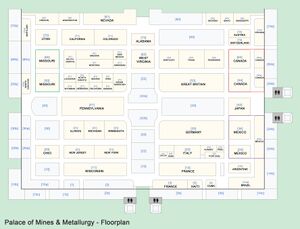 | |
The Palace of Mines and Metallurgy formed the inner part of the east fan-like plan of the Main Picture at the Exposition. It stood between Government Terrace and Art Hill, opposite the Palace of Liberal Arts. The palace contained displays, exhibits and classes pertaining to all aspects of mining. There were showcases of geology, rocks, minerals, and gems as well as machinery and maps.
Description[edit | edit source]
The architectural design of the Palace of Mines & Metallurgy was unique within the fair. The architect, Theo Link, described the style as 'Secession' architecture. It was modeled after the stone buildings of Ancient Egypt, due to their success in mining large stones from the earth.
The side walls of the building were set back 20 feet from the red tile roof, creating a large arcade treated with screens. Large lantern lights or 'monitors' allowed light to enter the space. Over the central entrances were finely modelled figures surrounding a globe supported by smaller figures.
The decorated massive piers had capitals derived from the Ionic. Small columns, Byzantine in feeling, rested upon a low screen wall between the piers. The sculptures expressed ideas related to mining.
During construction, a difficult vein of shale was discovered near the German Pavillion, which forced plans to be changed. Originally, the projecting roof and arcades were to be on all four sides, but the one on the south side had to be removed. The obelisks standing at the north and west entrances were to be on all four side, and were originally planned to be spaced out farther from the building. A metallic façade on the outer walls also had to be abandoned.
Notable Displays[edit | edit source]
Many states and nations had elaborate and diverse exhibits in the Palace of Mines.
Alabama[edit | edit source]
The most impressive item in the Palace of Mines and Metallurgy was the 120,000 pound statue of Vulcan the Roman god of the forge, Alabama's main exhibit at the Fair.
California[edit | edit source]
California exhibited demonstrations of both wet and dry gold mining.
Colorado[edit | edit source]
Colorado showed a scaled gold reduction plant that processed Black Hills gold. Visitors could also bring in one sample of ore for the Colorado State School to assess.
Maryland[edit | edit source]
Maryland had area of nearly 3,000 square feet of floor and showcased coal, building and decorative stones, ores, clays and clay products (including pottery, tile, terra cotta, fancy and common brick, fire brick, enameled brick, retorts and stove linings), limestones, sands, cement rocks, flints, feldspars, marls, tripoli, barites, and soapstone.
Louisiana[edit | edit source]
Louisiana's exhibit included a 850 pound biblical sculpture of Lot's wife carved in a block of salt. Also, their exhibit contained a column of Sulphur sculpted into a monument to Mephistopheles. The column weighed 2,400 pounds.
Texas[edit | edit source]
Texas exhibited a pot of mercury that weighed 1,200 pounds.
Canada[edit | edit source]
Canada wowed visitors with over 50,000 dollars of gold dust and nuggets.
Mexico[edit | edit source]
Mexico has some quality exhibits mostly pertaining to onyx and sculptured onyx and copper mining.
Gallery[edit | edit source]
-
View from the Lagoon
-
Main Door of the Palace
-
Side Door
-
Vulcan
-
Mine Model
-
Pennsylvania Model Coal Mine
-
Coal Mine Model
-
Wyoming Model Coal Mine
-
Section view of the rear entrance
